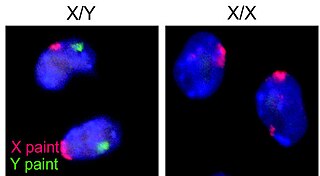 W
WA germ cell is any biological cell that gives rise to the gametes of an organism that reproduces sexually. In many animals, the germ cells originate in the primitive streak and migrate via the gut of an embryo to the developing gonads. There, they undergo meiosis, followed by cellular differentiation into mature gametes, either eggs or sperm. Unlike animals, plants do not have germ cells designated in early development. Instead, germ cells can arise from somatic cells in the adult, such as the floral meristem of flowering plants.
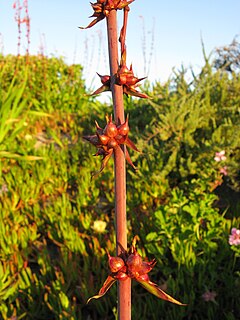 W
WIn biology and genetics, the germline is the population of a multicellular organism's cells that pass on their genetic material to the progeny (offspring). In other words, they are the cells that form the egg, sperm and the fertilised egg, as well as the fertilised egg's future sperm or egg cells. They are usually differentiated to perform this function and segregated in a specific place away from other bodily cells.
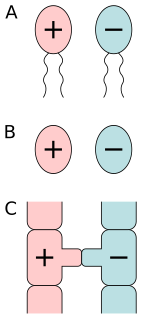 W
WAnisogamy is the form of sexual reproduction that involves the union or fusion of two gametes, which differ in size and/or form. The smaller gamete is considered to be male, whereas the larger gamete is regarded as female.
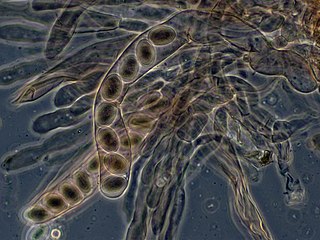 W
WAn ascospore is a spore contained in an ascus or that was produced inside an ascus. This kind of spore is specific to fungi classified as ascomycetes (Ascomycota).
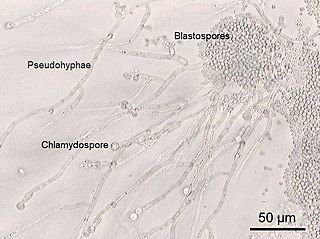 W
WA chlamydospore is the thick-walled large resting spore of several kinds of fungi, including Ascomycota such as Candida, Basidiomycota such as Panus, and various Mortierellales species. It is the life-stage which survives in unfavourable conditions, such as dry or hot seasons. Fusarium oxysporum which causes the plant disease Fusarium wilt is one which forms chlamydospores in response to stresses like nutrient depletion. Mycelia of the pathogen can survive in this manner and germinate in favorable conditions.
 W
WThe cortical reaction is a process initiated during fertilization by the release of cortical granules from the egg, which prevents polyspermy, the fusion of multiple sperm with one egg. In contrast to the fast block of polyspermy which immediately but temporarily blocks additional sperm from fertilizing the egg, the cortical reaction gradually establishes a permanent barrier to sperm entry and functions as the main part of the slow block of polyspermy in many animals.
 W
WThe egg cell, or ovum, is the female reproductive cell, or gamete, in most anisogamous organisms. The term is used when the female gamete is not capable of movement (non-motile). If the male gamete (sperm) is capable of movement, the type of sexual reproduction is also classified as oogamous.
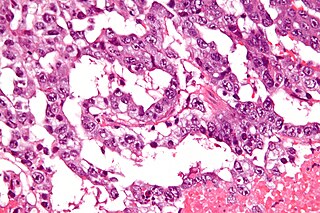 W
WAn Extracranial Germ-Cell Tumor (EGCT) occurs in the abnormal growth of germ cells in the gonads and the areas other than the brain via tissue, lymphatic system, or circulatory system. The tumor can be benign or malignant (cancerous) by its growth rate. According to the National Cancer Institute and St. Jude Children's Research Hospital, the chance of children who are under 15 years old having EGCTs is 3%, in comparison to adolescents, a possibility of 14% with aged 15 to 19 can have EGCTs. There is no obvious cut point in between children and adolescents. However, common cut points in researches are 11 years old and 15 years old.
 W
WIn biology, folliculogenesis is the maturation of the ovarian follicle, a densely packed shell of somatic cells that contains an immature oocyte. Folliculogenesis describes the progression of a number of small primordial follicles into large preovulatory follicles that occurs in part during the menstrual cycle.
 W
WA gamete is a haploid cell that fuses with another haploid cell during fertilization in organisms that sexually reproduce. In species that produce two morphologically distinct types of gametes, and in which each individual produces only one type, a female is any individual that produces the larger type of gamete—called an ovum— and a male produces the smaller tadpole-like type—called a sperm. In short a gamete is an egg cell or a sperm. This is an example of anisogamy or heterogamy, the condition in which females and males produce gametes of different sizes. In contrast, isogamy is the state of gametes in a species being the same size and shape, in isogamy there is no male or female sex and given arbitrary designators for mating type. The name gamete was introduced by the German cytologist Eduard Strasburger. Gametes carry half the genetic information of an individual, one ploidy of each type, and are created through meiosis.
 W
WA gametocyte is a eukaryotic germ cell that divides by mitosis into other gametocytes or by meiosis into gametids during gametogenesis. Male gametocytes are called spermatocytes, and female gametocytes are called oocytes.
 W
WGametogenesis is a biological process by which diploid or haploid precursor cells undergo cell division and differentiation to form mature haploid gametes. Depending on the biological life cycle of the organism, gametogenesis occurs by meiotic division of diploid gametocytes into various gametes, or by mitosis. For example, plants produce gametes through mitosis in gametophytes. The gametophytes grow from haploid spores after sporic meiosis. The existence of a multicellular, haploid phase in the life cycle between meiosis and gametogenesis is also referred to as alternation of generations.
 W
WGerm plasm is a biological concept developed in the 19th century by the German biologist August Weismann. It states that heritable information is transmitted only by germ cells in the gonads, not by somatic cells. The related idea that information cannot pass from somatic cells to the germ line, contrary to Lamarckism, is called the Weismann barrier. The theory to some extent anticipated the development of modern genetics.
 W
WIsogamy is a form of sexual reproduction that involves gametes of similar morphology, differing in general only in allele expression in one or more mating-type regions. Because both gametes look alike, they cannot be classified as "male" or "female". Instead, organisms undergoing isogamy are said to have different mating types, most commonly noted as "+" and "−" strains, although in some species of Basidiomycota there are more than two mating types, some can even have thousands of mating types. In all cases, fertilization occurs when gametes of two different mating types fuse to form a zygote.
 W
WOogamy is the familiar form of sexual reproduction. It is a form of anisogamy (heterogamy) in which the female gamete is significantly larger than the male gamete and is non-motile. The male gametes are typically highly motile and are usually tasked with all of the travel necessary to bring the respective gametes together. The prevalence of oogamy in higher animals leads to the conclusion that this specialization of the gametes results in their performing their respective tasks better and more efficiently than those tasks could be performed by generalist isogametes, particularly the ability to concentrate high-energy substances in a smaller number of ova.
 W
WA polar body is a small haploid cell that is formed concomitantly as an egg cell during oogenesis, but generally does not have the ability to be fertilized.
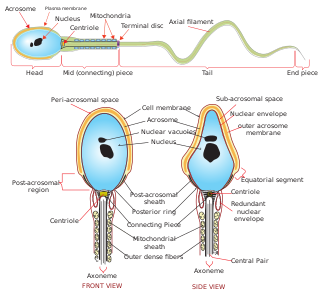 W
WSperm is the male reproductive cell, or gamete, in anisogamous forms of sexual reproduction. Animals produce motile sperm with a tail known as a flagellum, which are known as spermatozoa, while some red algae and fungi produce non-motile sperm cells, known as spermatia. Flowering plants contain non-motile sperm inside pollen, while some more basal plants like ferns and some gymnosperms have motile sperm.
 W
WThe spermatid is the haploid male gametid that results from division of secondary spermatocytes. As a result of meiosis, each spermatid contains only half of the genetic material present in the original primary spermatocyte.
 W
WSpermatocytes are a type of male gametocyte in animals. They derive from immature germ cells called spermatogonia. They are found in the testis, in a structure known as the seminiferous tubules. There are two types of spermatocytes, primary and secondary spermatocytes. Primary and secondary spermatocytes are formed through the process of spermatocytogenesis.
 W
WA spermatogonium is an undifferentiated male germ cell. Spermatogonia undergo spermatogenesis to form mature spermatozoa in the seminiferous tubules of the testis.
 W
WA spermatozoon is a motile sperm cell, or moving form of the haploid cell that is the male gamete. A spermatozoon joins an ovum to form a zygote.
 W
WIn biology, a spore is a unit of sexual or asexual reproduction that may be adapted for dispersal and for survival, often for extended periods of time, in unfavourable conditions. Spores form part of the life cycles of many plants, algae, fungi and protozoa. Bacterial spores are not part of a sexual cycle but are resistant structures used for survival under unfavourable conditions. Myxozoan spores release amoebulae into their hosts for parasitic infection, but also reproduce within the hosts through the pairing of two nuclei within the plasmodium, which develops from the amoebula.
 W
WTeliospore is the thick-walled resting spore of some fungi, from which the basidium arises.
 W
WVitellogenesis is the process of yolk formation via nutrients being deposited in the oocyte, or female germ cell involved in reproduction of lecithotrophic organisms. In insects, it starts when the fat body stimulates the release of juvenile hormones and produces vitellogenin protein. It occurs in all animal groups other than the mammals. In cockroaches, for example, vitellogenesis can be stimulated by injection of juvenile hormone into immature females and mature males. Chemically yolk is lipoprotein composed of proteins, phospholipids and neutral fats along with a small amount of glycogen. The yolk is synthesised in the liver of the female parent in soluble form. Through circulation it is transported to the follicle cells that surround the maturing ovum, and is deposited in the form of yolk platelets and granules in the ooplasm. The mitochondria and Golgi complex are said to bring about the conversion of the soluble form of yolk into insoluble granules or platelets.